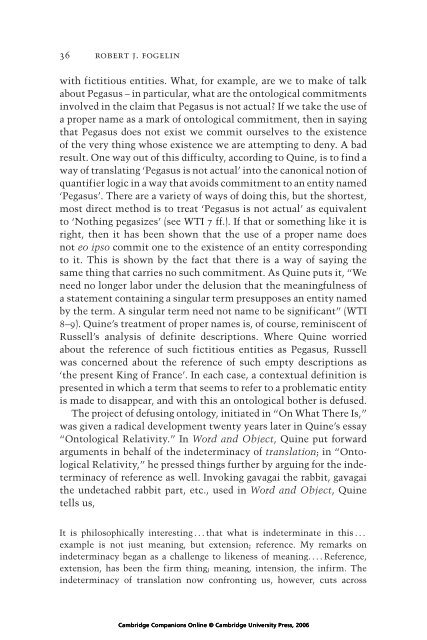Willard Van Orman Quine
Willard Van Orman Quine
Willard Van Orman Quine
Create successful ePaper yourself
Turn your PDF publications into a flip-book with our unique Google optimized e-Paper software.
36 robert j. fogelin<br />
with fictitious entities. What, for example, are we to make of talk<br />
about Pegasus – in particular, what are the ontological commitments<br />
involved in the claim that Pegasus is not actual? If we take the use of<br />
a proper name as a mark of ontological commitment, then in saying<br />
that Pegasus does not exist we commit ourselves to the existence<br />
of the very thing whose existence we are attempting to deny. A bad<br />
result. One way out of this difficulty, according to <strong>Quine</strong>, is to find a<br />
way of translating ‘Pegasus is not actual’ into the canonical notion of<br />
quantifier logic in a way that avoids commitment to an entity named<br />
‘Pegasus’. There are a variety of ways of doing this, but the shortest,<br />
most direct method is to treat ‘Pegasus is not actual’ as equivalent<br />
to ‘Nothing pegasizes’ (see WTI 7 ff.). If that or something like it is<br />
right, then it has been shown that the use of a proper name does<br />
not eo ipso commit one to the existence of an entity corresponding<br />
to it. This is shown by the fact that there is a way of saying the<br />
same thing that carries no such commitment. As <strong>Quine</strong> puts it, “We<br />
need no longer labor under the delusion that the meaningfulness of<br />
a statement containing a singular term presupposes an entity named<br />
by the term. A singular term need not name to be significant” (WTI<br />
8–9). <strong>Quine</strong>’s treatment of proper names is, of course, reminiscent of<br />
Russell’s analysis of definite descriptions. Where <strong>Quine</strong> worried<br />
about the reference of such fictitious entities as Pegasus, Russell<br />
was concerned about the reference of such empty descriptions as<br />
‘the present King of France’. In each case, a contextual definition is<br />
presented in which a term that seems to refer to a problematic entity<br />
is made to disappear, and with this an ontological bother is defused.<br />
The project of defusing ontology, initiated in “On What There Is,”<br />
was given a radical development twenty years later in <strong>Quine</strong>’s essay<br />
“Ontological Relativity.” In Word and Object, <strong>Quine</strong> put forward<br />
arguments in behalf of the indeterminacy of translation; in “Ontological<br />
Relativity,” he pressed things further by arguing for the indeterminacy<br />
of reference as well. Invoking gavagai the rabbit, gavagai<br />
the undetached rabbit part, etc., used in Word and Object, <strong>Quine</strong><br />
tells us,<br />
It is philosophically interesting...that what is indeterminate in this...<br />
example is not just meaning, but extension; reference. My remarks on<br />
indeterminacy began as a challenge to likeness of meaning....Reference,<br />
extension, has been the firm thing; meaning, intension, the infirm. The<br />
indeterminacy of translation now confronting us, however, cuts across<br />
Cambridge Companions Online © Cambridge University Press, 2006
















